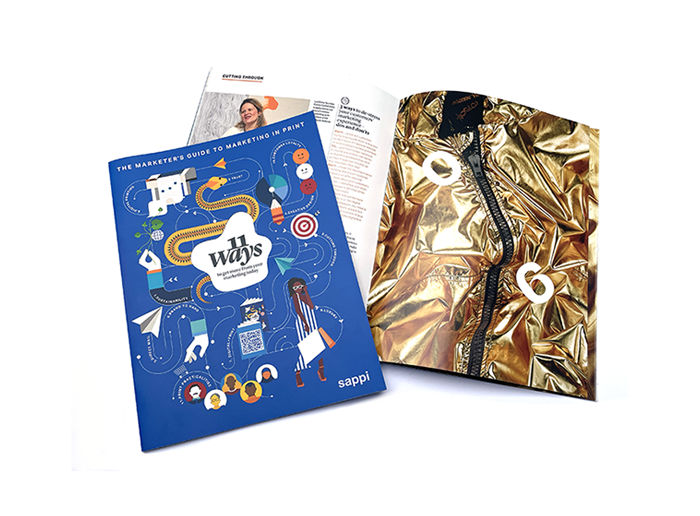Print for Customer Loyalty: Emotional Connections
What makes print the ideal medium for maintaining customer loyalty?

Nurturing customer loyalty is a cornerstone of any thriving business. As a marketing medium, print possesses a number of key characteristics – including emotional connection and stronger recall – that will help engage and keep hold of customers.
But what’s so important about making efforts to keep customers loyal in the first place? For one, it makes financial sense. According to Ali Cudby, adjunct professor of entrepreneurship at Purdue University in the US, it costs 6-7 times more to get new customers than it does to retain existing ones.

And as Cudby lists in her 2020 book Keep Your Customers, loyal customers stay with a company longer, spend more money and are an irreplaceable fount of recommendations and referrals.
Print has a unique role to play here as it boasts attributes that not only generate important emotional connections with consumers, but that also bring advantages when it comes to brand recall and information retention. Attributes that digital screens can’t replicate.
A 2019 study by the United States Postal Service, which used fMRI brain scans and eye tracking technology, concluded that print ads were better than digital for brand recall and for leaving a lasting impression. Meanwhile, a 2015 report from Temple University (also in the US) demonstrated that print elicited a greater emotional response among subjects when measuring their heart rates and breathing patterns.
It’s the haptic nature of print – the fact that it is a physical object that has texture and can be held and touched – that is key when it comes to retaining attention and drawing consumers in.
“This trait offers an advantage for brands using print. A simple brochure can create a stronger emotional connection with the recipient than something they cannot physically touch.”
That’s why so many luxury fashion brands, forced by the pandemic to cancel catwalk shows, chose not only to promote their new collections online but also to exploit the physical nature of print to keep customers loyal. The likes of Chanel, Dior, Prada, Loewe and Alighieri invested in sending books, handwritten notes and other glossy, printed materials to their top spending customers.
Talking to Vogue Business, Alighieri founder Rosh Mahtani described how seeking the power to “truly bring people into our universe” led the brand to turn to print. “There is nothing digital that could possibly compare to physical,” she said.
Jen Clinehens, customer experience strategy director at global ad and marketing agency Havas, is very much on the same page.
“The goal is not to send direct advertising out to everybody, but to craft relationships with customers. For some, if they open a Chanel book and get a glossy, beautiful experience, it’s something they can collect and keep. In that sense, it almost becomes an extension of retail and the brand’s storytelling.”

Print also has the simple power to make customers feel special. After all, anyone can send an email (or programme a bot to send one), but a magazine in the post shows that a company genuinely values you and your custom. Which is why the likes of Air Canada and United Airlines mailed inflight magazines to elite customers during the pandemic, despite the fact that most of their planes were grounded.
Similarly, P&O Cruises (an unconnected entity to P&O Ferries) kept creating and printing new issues of its Moments customer magazine throughout the pandemic – because it constituted a key element of its customer loyalty programme. With cruise ships confined to ports, the brand didn’t actually have a product to sell or ways to monetise the magazine, but it still mailed out Moments to its loyalty club members – a strong brand message in itself.
As Myers notes in his white paper: “Uniquely, when used in the right way, print moves beyond a medium to become an extension of the brand.”
Four ways to use print to help turn happy customers into loyal advocates
1 Boost brand connection with a brochure

As brands as diverse as Amazon, UK homeware retailer Cox & Cox and German fashion giant bonprix can attest, a well-targeted brochure or catalogue can do a valuable job keeping your customers loyal and engaged. According to the Association of American Advertisers, response rates for catalogues are steadily climbing, while a study last year by the Harvard Business Review found that sending consumers a catalogue can boost purchase rates by 24%.

2 Create your own brand club with a smartly positioned customer magazine
Customer magazines aren’t just for luxury brands such as Dunhill and Gucci.

Last year, mid-range UK women’s fashion retailer Sahara printed 40,000 copies of their winter customer publication. In the US, furniture retailer California Closets publishes Ideas of Order, a magazine that doesn’t even try to sell products – but that still managed to achieve a remarkable ROI of $42 for every dollar spent when it launched a few years ago. In the B2B world, Swedish mining company Epiroc sums up its approach to its own magazine by affirming that it “helps build trust” with customers.
3 Use a print campaign to reveal your human side
Print ads don’t always have to be about selling stuff – they can also be used to connect with consumers and show that your brand understands them. A prime example was a campaign run by KFC in the UK in 2018. When supply problems meant the fast-food chain had to temporarily shut 800 restaurants, the brand ran a humorous ‘FCK’ print campaign to apologise – which then quickly became a hit in its own right.

4 Get up close and personal using direct mail
The flexibility of direct mail makes it perfect for kindling customer loyalty. You can divide customers into specific target groups according to their preferences, or even personalise each piece of mail.

Meanwhile, sending special offers and coupons puts your brand message in front of the customer and can boost perception and engagement in a no-fuss way. Direct mail is also a great way to re-engage lacklustre customers or find new ones through referral programmes (eg send two gift cards – one for the advocate, one for the friend). And, most importantly, it works – a 2020 JICMAIL report found that 95% of consumers engage with DM.



